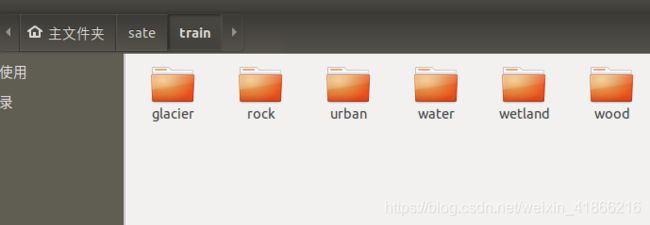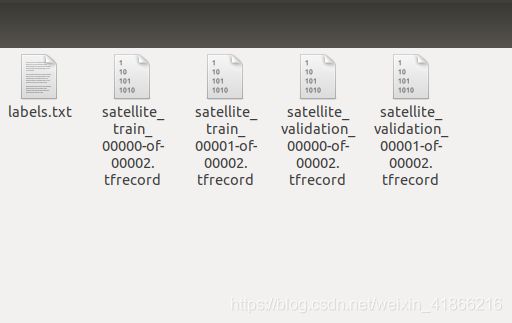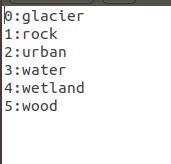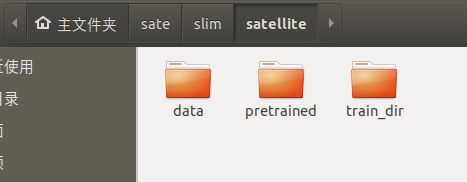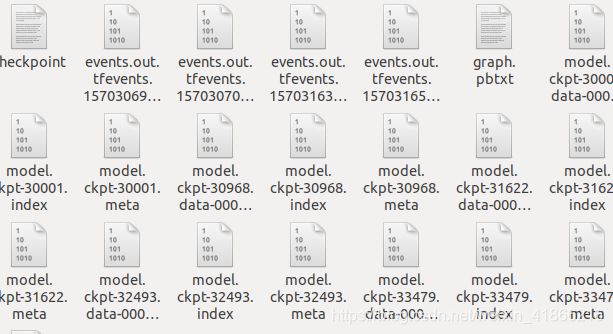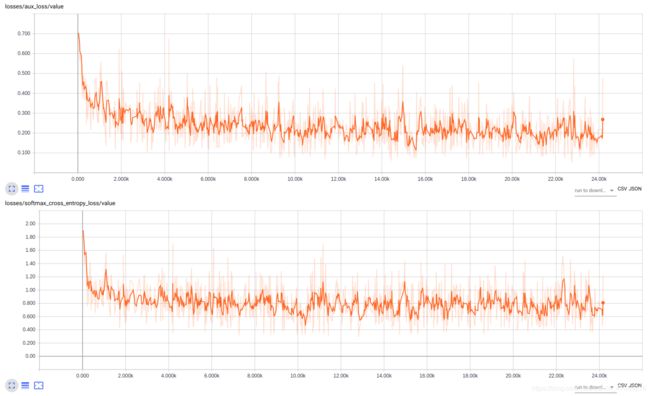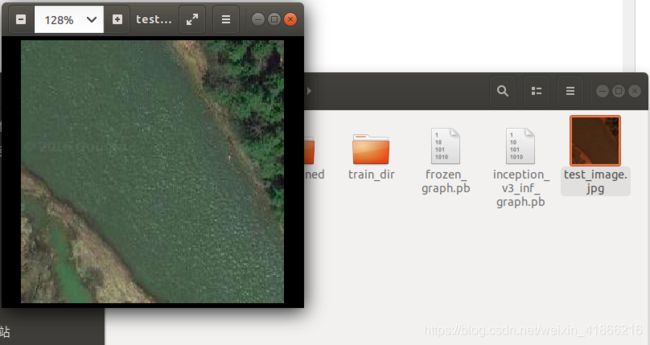基于tf-slim 的卫星区域地形的分类模型的训练。
数据准备
1数据介绍
数据是关于卫星图像的数据,一共包括 森林:wood 水域:water 岩石:rock 农田:wetland 冰川:galcier 城市区域:urban 6个类别。
训练数据一共包含4800张图片,每个类别有一个对应的文件夹,其中存放该类数据。
2 数据转换
我们要把数据转换成tf-record格式,还要生成一个包含类别与id对应信息的文件:lable.txt。
1下载tf-slim框架的源码
2修改slim源码的代码
程序的入口download_and_convert_data.py
from datasets import download_and_convert_cifar10
from datasets import download_and_convert_flowers
from datasets import download_and_convert_mnist
from datasets import download_and_convert_satellitedef main(_):
if not FLAGS.dataset_name:
raise ValueError('You must supply the dataset name with --dataset_name')
if not FLAGS.dataset_dir:
raise ValueError('You must supply the dataset directory with --dataset_dir')
if FLAGS.dataset_name == 'cifar10':
download_and_convert_cifar10.run(FLAGS.dataset_dir)
elif FLAGS.dataset_name == 'flowers':
download_and_convert_flowers.run(FLAGS.dataset_dir)
elif FLAGS.dataset_name == 'mnist':
download_and_convert_mnist.run(FLAGS.dataset_dir)
elif FLAGS.dataset_name == 'satellite':
download_and_convert_satellite.run(FLAGS.dataset_dir)
else:
raise ValueError(
'dataset_name [%s] was not recognized.' % FLAGS.dataset_dir)
首先我们要倒入实现我们数据转换的文件 download_and_convert_satellite.py
然后要根据我们传入的数据名satellite来调用这个程序
建立download_and_convert_satellite.py文件
# Copyright 2016 The TensorFlow Authors. All Rights Reserved.
#
# Licensed under the Apache License, Version 2.0 (the "License");
# you may not use this file except in compliance with the License.
# You may obtain a copy of the License at
#
# http://www.apache.org/licenses/LICENSE-2.0
#
# Unless required by applicable law or agreed to in writing, software
# distributed under the License is distributed on an "AS IS" BASIS,
# WITHOUT WARRANTIES OR CONDITIONS OF ANY KIND, either express or implied.
# See the License for the specific language governing permissions and
# limitations under the License.
# ==============================================================================
r"""Downloads and converts Flowers data to TFRecords of TF-Example protos.
This module downloads the Flowers data, uncompresses it, reads the files
that make up the Flowers data and creates two TFRecord datasets: one for train
and one for test. Each TFRecord dataset is comprised of a set of TF-Example
protocol buffers, each of which contain a single image and label.
The script should take about a minute to run.
"""
from __future__ import absolute_import
from __future__ import division
from __future__ import print_function
import math
import os
import random
import sys
import tensorflow as tf
from datasets import dataset_utils
_NUM_VALIDATION = 1000
# Seed for repeatability.
_RANDOM_SEED = 0
# The number of shards per dataset split.
_NUM_SHARDS = 2
class ImageReader(object):
"""Helper class that provides TensorFlow image coding utilities."""
def __init__(self):
# Initializes function that decodes RGB JPEG data.
self._decode_jpeg_data = tf.placeholder(dtype=tf.string)
self._decode_jpeg = tf.image.decode_jpeg(self._decode_jpeg_data, channels=3)
self._decode_jpeg = tf.image.resize_images(self._decode_jpeg, (320, 320))
def read_image_dims(self, sess, image_data):
#image = self.decode_jpeg(sess, image_data)
return 320, 320
def decode_jpeg(self, sess, image_data):
image = sess.run(self._decode_jpeg,
feed_dict={self._decode_jpeg_data: image_data})
assert len(image.shape) == 3
assert image.shape[2] == 3
return image
def _get_filenames_and_classes(dataset_dir):
"""Returns a list of filenames and inferred class names.
Args:
dataset_dir: A directory containing a set of subdirectories representing
class names. Each subdirectory should contain PNG or JPG encoded images.
Returns:
A list of image file paths, relative to `dataset_dir` and the list of
subdirectories, representing class names.
"""
#flower_root = os.path.join(dataset_dir, 'quiz')
flower_root = dataset_dir
directories = []
class_names = []
for filename in os.listdir(flower_root):
path = os.path.join(flower_root, filename)
if os.path.isdir(path):
directories.append(path)
class_names.append(filename)
photo_filenames = []
for directory in directories:
for filename in os.listdir(directory):
path = os.path.join(directory, filename)
photo_filenames.append(path)
return photo_filenames, sorted(class_names)
def _get_dataset_filename(dataset_dir, split_name, shard_id):
output_filename = 'satellite_%s_%05d-of-%05d.tfrecord' % (
split_name, shard_id, _NUM_SHARDS)
return os.path.join(dataset_dir, output_filename)
def _convert_dataset(split_name, filenames, class_names_to_ids, dataset_dir):
"""Converts the given filenames to a TFRecord dataset.
Args:
split_name: The name of the dataset, either 'train' or 'validation'.
filenames: A list of absolute paths to png or jpg images.
class_names_to_ids: A dictionary from class names (strings) to ids
(integers).
dataset_dir: The directory where the converted datasets are stored.
"""
assert split_name in ['train', 'validation']
num_per_shard = int(math.ceil(len(filenames) / float(_NUM_SHARDS)))
with tf.Graph().as_default():
image_reader = ImageReader()
with tf.Session('') as sess:
for shard_id in range(_NUM_SHARDS):
output_filename = _get_dataset_filename(
dataset_dir, split_name, shard_id)
with tf.python_io.TFRecordWriter(output_filename) as tfrecord_writer:
start_ndx = shard_id * num_per_shard
end_ndx = min((shard_id + 1) * num_per_shard, len(filenames))
for i in range(start_ndx, end_ndx):
sys.stdout.write('\r>> Converting image %d/%d shard %d' % (
i + 1, len(filenames), shard_id))
sys.stdout.flush()
# Read the filename:
image_data = tf.gfile.FastGFile(filenames[i], 'rb').read()
height, width = image_reader.read_image_dims(sess, image_data)
class_name = os.path.basename(os.path.dirname(filenames[i]))
class_id = class_names_to_ids[class_name]
example = dataset_utils.image_to_tfexample(
image_data, b'jpg', height, width, class_id)
tfrecord_writer.write(example.SerializeToString())
sys.stdout.write('\n')
sys.stdout.flush()
def _dataset_exists(dataset_dir):
for split_name in ['train', 'validation']:
for shard_id in range(_NUM_SHARDS):
output_filename = _get_dataset_filename(
dataset_dir, split_name, shard_id)
if not tf.gfile.Exists(output_filename):
return False
return True
def run(dataset_dir):
"""Runs the download and conversion operation.
Args:
dataset_dir: The dataset directory where the dataset is stored.
"""
if not tf.gfile.Exists(dataset_dir):
tf.gfile.MakeDirs(dataset_dir)
if _dataset_exists(dataset_dir):
print('Dataset files already exist. Exiting without re-creating them.')
return
photo_filenames, class_names = _get_filenames_and_classes(dataset_dir)
class_names_to_ids = dict(zip(class_names, range(len(class_names))))
# Divide into train and test:
random.seed(_RANDOM_SEED)
random.shuffle(photo_filenames)
training_filenames = photo_filenames[_NUM_VALIDATION:]
validation_filenames = photo_filenames[:_NUM_VALIDATION]
# First, convert the training and validation sets.
_convert_dataset('train', training_filenames, class_names_to_ids,
dataset_dir)
_convert_dataset('validation', validation_filenames, class_names_to_ids,
dataset_dir)
# Finally, write the labels file:
labels_to_class_names = dict(zip(range(len(class_names)), class_names))
dataset_utils.write_label_file(labels_to_class_names, dataset_dir)
print('\nFinished converting the Flowers dataset!')3建立我们数据集文件satellite.py
# Copyright 2016 The TensorFlow Authors. All Rights Reserved.
#
# Licensed under the Apache License, Version 2.0 (the "License");
# you may not use this file except in compliance with the License.
# You may obtain a copy of the License at
#
# http://www.apache.org/licenses/LICENSE-2.0
#
# Unless required by applicable law or agreed to in writing, software
# distributed under the License is distributed on an "AS IS" BASIS,
# WITHOUT WARRANTIES OR CONDITIONS OF ANY KIND, either express or implied.
# See the License for the specific language governing permissions and
# limitations under the License.
# ==============================================================================
"""Provides data for the flowers dataset.
The dataset scripts used to create the dataset can be found at:
tensorflow/models/research/slim/datasets/download_and_convert_flowers.py
"""
from __future__ import absolute_import
from __future__ import division
from __future__ import print_function
import os
import tensorflow as tf
from datasets import dataset_utils
slim = tf.contrib.slim
_FILE_PATTERN = 'satellite_%s_*.tfrecord'
SPLITS_TO_SIZES = {'train': 4000, 'validation': 1000}
_NUM_CLASSES = 6
_ITEMS_TO_DESCRIPTIONS = {
'image': 'A color image of varying size.',
'label': 'A single integer between 0 and 99',
}
def get_split(split_name, dataset_dir, file_pattern=None, reader=None):
"""Gets a dataset tuple with instructions for reading flowers.
Args:
split_name: A train/validation split name.
dataset_dir: The base directory of the dataset sources.
file_pattern: The file pattern to use when matching the dataset sources.
It is assumed that the pattern contains a '%s' string so that the split
name can be inserted.
reader: The TensorFlow reader type.
Returns:
A `Dataset` namedtuple.
Raises:
ValueError: if `split_name` is not a valid train/validation split.
"""
if split_name not in SPLITS_TO_SIZES:
raise ValueError('split name %s was not recognized.' % split_name)
if not file_pattern:
file_pattern = _FILE_PATTERN
file_pattern = os.path.join(dataset_dir, file_pattern % split_name)
# Allowing None in the signature so that dataset_factory can use the default.
if reader is None:
reader = tf.TFRecordReader
keys_to_features = {
'image/encoded': tf.FixedLenFeature((), tf.string, default_value=''),
'image/format': tf.FixedLenFeature((), tf.string, default_value='png'),
'image/class/label': tf.FixedLenFeature(
[], tf.int64, default_value=tf.zeros([], dtype=tf.int64)),
}
items_to_handlers = {
'image': slim.tfexample_decoder.Image(),
'label': slim.tfexample_decoder.Tensor('image/class/label'),
}
decoder = slim.tfexample_decoder.TFExampleDecoder(
keys_to_features, items_to_handlers)
labels_to_names = None
if dataset_utils.has_labels(dataset_dir):
labels_to_names = dataset_utils.read_label_file(dataset_dir)
return slim.dataset.Dataset(
data_sources=file_pattern,
reader=reader,
decoder=decoder,
num_samples=SPLITS_TO_SIZES[split_name],
items_to_descriptions=_ITEMS_TO_DESCRIPTIONS,
num_classes=_NUM_CLASSES,
labels_to_names=labels_to_names)3运行程序
python slim/download_and_convert_data.py --dataset_dir=./train --dataset_name=satellite
生成的文件如下
lable.txt文件内容
3 训练和验证
预训练模型下载:
http://download.tensorflow.org/models/inception_v3_2016_08_28.tar.gz
解压之后训练的时候用
准备训练
在silm目录下建立一个satellite 文件夹
data文件夹存放训练用数据
pretrained 存放预训练模型
train_dir 是存放训练日志文件夹
python train_image_classifier.py \
--train_dir=satellite/train_dir #训练日志保存的地方\
--dataset_name=satellite \
--dataset_split_name=train \
--dataset_dir=satellite/data \
--model_name=inception_v3 \
--checkpoint_path=satellite/pretrained/inception_v3.ckpt \
--checkpoint_exclude_scopes=InceptionV3/Logits,InceptionV3/AuxLogits \
--trainable_scopes=InceptionV3/Logits,InceptionV3/AuxLogits \
--max_number_of_steps=50000 \
--batch_size=16 \
--learning_rate=0.001 \
--learning_rate_decay_type=fixed \
--save_interval_secs=300 \
--save_summaries_secs=2 \
--log_every_n_steps=10 \
--optimizer=rmsprop \
--weight_decay=0.00004
我是训练大约50000steps。loss从2.4讲到1.0+。
下面是我们保存的ckpt
接下来验证
python eval_image_classifier.py \
--checkpoint_path=satellite/train_dir \
--eval_dir=satellite/eval_dir \
--dataset_name=satellite \
--dataset_split_name=validation \
--dataset_dir=satellite/data \
--model_name=inception_v3
验证的结果
使用tensorboard查看我们训练过程
4导出训练好的模型
python export_inference_graph.py \
> --alsologtostderr \
> --model_name=inception_v3 \
> --output_file=satellite/inception_v3_inf_graph.pb \
> --dataset_name satellite
INFO:tensorflow:Scale of 0 disables regularizer.
这一步是把我们模型的网络结构导出,但是这里并不包含我们训练好的参数。下一步我们要把模型的参数保存到这个结构中
python freeze_graph.py \
--input_graph satellite/inception_v3_inf_graph.pb \
--input_checkpoint satellite/train_dir/model.ckpt-33479 \
--input_binary true \
--output_node_names InceptionV3/Predictions/Reshape_1 \
--output_graph satellite/frozen_graph.pb
注意:文件的路径是否正确!
这是生成的文件。
5使用模型对单张图片进行预测
测试图片:
使用模型进行预测。
python classify_image_inception_v3.py \
--model_path satellite/frozen_graph.pb \
--label_path satellite/data/labels.txt \
--image_file satellite/test_image.jpg结果
3:water (score = 3.75095)
4:wetland (score = 0.75999)
2:urban (score = 0.09909)
1:rock (score = -0.42465)
5:wood (score = -0.56796)
最好的是水域water 正确。
